Loading AI tools
From Wikipedia, the free encyclopedia
This article lists the monarchs of Punjab from the ancient kingdom of Sindhu-Sauvīra around 1000 BC until the deposition of the Sikh Empire in 1849.[1]
| Maharaja of Punjab | |
|---|---|
 Seal of Ranjit Singh | |
 | |
| Details | |
| Style | |
| First monarch | Udayana 6th century – 5th century BC (first known ruler) |
| Last monarch | Duleep Singh 1843–1849 (as Maharaja of Punjab) |
| Formation | 11th century BC |
| Abolition | 29 March 1849 |
| Residence | List
|
| Appointer | Hereditary |
| Pretender(s) | none (House extinct) |

| Name | Image | Comments | Dates |
|---|---|---|---|
| Darius I | 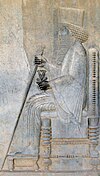 |
King of Persia in addition to Pharaoh of Egypt. Cousin of Cambyses II and Bardiya. | 513–486 BC |
| Xerxes I | 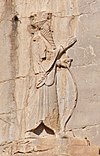 |
King of Persia in addition to Pharaoh of Egypt | 486–465 BC |
| Artaxerxes I |  |
King of Persia in addition to Pharaoh of Egypt | 465–424 BC |
| Xerxes II |  |
King of Persia in addition to Pharaoh of Egypt. Assassinated by his half-brother and successor, Sogdianus. | 424 BC (45 days) |
| Sogdianus |  |
King of Persia in addition to Pharaoh of Egypt | 424–423 BC |
| Darius II |  |
King of Persia in addition to Pharaoh of Egypt. His birth name was Ochus. | 423–405 BC |
| Artaxerxes II | 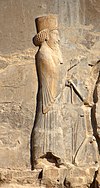 |
King of Persia. Ruling for 47 years, Artaxerxes II was the longest reigning Achaemenid king. His birth name was Arses. | 405–358 BC |
| Artaxerxes III | 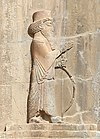 |
King of Persia in addition to Pharaoh of Egypt, having re-conquered the land after it was lost during the reign of Artaxerxes II. His birth name was Ochus. | 358–338 BC |

| Name | Reign | Succession | Life details |
|---|---|---|---|
| Alexander III "the Great" | 326 – 323 (3 years) |
Son of Philip II | 356 – 10/11 June 323 (aged 33) Conquered the entirety of the Persian Empire; died of illness at Babylon[2] |
| Philip III Arrhidaeus | 323 – 317 (6 years) |
Son of Philip II; co-ruler with Alexander IV | c. 358 – 317 (aged 41)[3] Owing to his diminished mental capacity, Philip never ruled in his own right and instead went through a series of regents; executed by Olympias.[4] |
| Alexander IV | 323 – 316 (7 years) |
Son of Alexander III; co-ruler with Philip III | 323 – 316 (aged 13) Due to his age, Alexander never ruled in his own right. Alexander III's mother, Olympias, guarded him until her execution in 316; murdered by Cassander.[4] |

| Ruler | Reign | Notes | |
|---|---|---|---|
| Chandragupta Maurya | 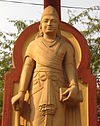 | 322–297 BCE | Founder of first Indian united empire. |
| Bindusara | 297–273 BCE | Known for his foreign diplomacy and crushed of Vidarbha revolt. | |
| Ashoka |  | 268–232 BCE | Greatest emperor of dynasty. His son Kunala was blinded and died before his father. Ashoka was succeeded by his grandson. Also known for Kalinga War victory. |
| Dasharatha Maurya |  | 232–224 BCE | Grandson of Ashoka. |
| Samprati |  | 224–215 BCE | Brother of Dasharatha. |
| Shalishuka | 215–202 BCE | ||
| Devavarman | 202–195 BCE | ||
| Shatadhanvan | 195–187 BCE | The Mauryan Empire had shrunk by the time of his reign | |
| Brihadratha | 187–184 BCE | Assassinated by his Commander-in-chief Pushyamitra Shunga in 185 BCE. | |


| Ruler | Image | Title | Approx. dates | Mentions |
|---|---|---|---|---|
| Hagamasha | Satrap | 1st century BCE | In the archaeological excavations of Sonkh, near Mathura, the earliest coins of the Kshatrapa levels were those of Hagamasha.[6] | |
| Hagana | Satrap | 1st century BCE | ||
| Rajuvula | Great Satrap | early 1st century BCE | ||
| Bhadayasa | Satrap | 1st century CE | Possible successor of Rajuvula in Eastern Punjab | |
| Sodasa | Satrap | 1st century CE | Son of Rajuvula in Mathura | |
| Kharapallana | Great Satrap | c. CE 130 | Great Satrap for Kushan ruler Kanishka I | |
| Vanaspara | Satrap | c. CE 130 | Satrap for Kushan ruler Kanishka I |


| Ruler | Reign (CE) | Notes | |
|---|---|---|---|
| Sri-Gupta I | c. late 3rd century CE | Founder of the dynasty. | |
| Ghatotkacha | 280/290–319 CE | ||
| Chandra-Gupta I |  | 319–335 CE | His title Maharajadhiraja ("king of great kings") suggests that he was the first emperor of the dynasty. It is not certain how he turned his small ancestral kingdom into an empire, although a widely accepted theory among modern historians is that his marriage to the Licchavi princess Kumaradevi helped him extend his political power. |
| Samudra-Gupta |  | 335–375 CE | Defeated several kings of northern India, and annexed their territories to his empire. He also marched along the south-eastern coast of India, advancing as far as the Pallava kingdom. In addition, he subjugated several frontier kingdoms and tribal oligarchies. His empire extended from Ravi River in the west to the Brahmaputra River in the east, and from the Himalayan foothills in the north to central India in the south-west; several rulers along the south-eastern coast were his tributaries. |
| Kacha | mid 4th century CE | Rival brother/king, possibly an usurper, there are coins who attest him as ruler; possibly identical with Samudra-Gupta. | |
| Rama-Gupta | |||
| Chandra-Gupta II Vikramaditya |  | 375–415 CE | Continued the expansionist policy of his father Samudragupta: historical evidence suggests that he defeated the Western Kshatrapas, and extended the Gupta empire from the Indus River in the west to the Bengal region in the east, and from the Himalayan foothills in the north to the Narmada River in the south. |
| Kumara-Gupta I |  | 415–455 CE | He seems to have maintained control of his inherited territory, which extended from Gujarat in the west to Bengal region in the east. |
| Skanda-Gupta |  | 455–467 CE | It is stated that he restored the fallen fortunes of the Gupta family, which has led to suggestions that during his predecessor's last years, the Empire may have suffered reverses, possibly against the Pushyamitras or the Hunas. He is generally considered the last of the great Gupta Emperors. |
| Puru-Gupta | 467–473 CE | ||
| Kumara-Gupta II Kramaditya |  | 473–476 CE | |
| Buddha-Gupta |  | 476–495 CE | He had close ties with the rulers of Kannauj and together they sought to run the Alchon Huns (Hunas) out of the fertile plains of Northern India. |

| Yosada | c.335 CE[8] |
| (Unknown) | fl. 388/400 |
| Varhran (II) | fl. c. 425 |
| Goboziko | fl. c. 450 |
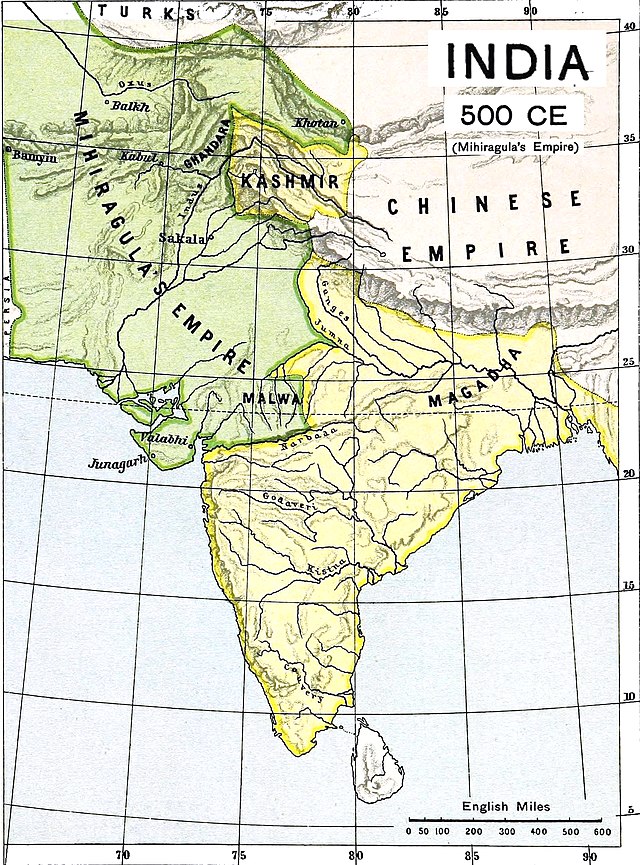

The Taanks (Takkas) were people from a variety of clans forming a kingdom. The rulers of the kingdom are only known from sources of chronicles and minted coins.[9] During this rule (630 AD), Lahore was said to have been visited by the Chinese pilgrim Hieun Tsang. He described it as a great Brahmin city.
Note: Not listed chronologically.



| Caliph | Reign |
|---|---|
| Caliphs of Damascus | |
| al-Walid I ibn Abd al-Malik | 712 – 23 February 715 |
| Sulayman ibn Abd al-Malik | 23 February 715 – 22 September 717 |
| Umar ibn Abd al-Aziz | 22 September 717 – 4 February 720 |
| Yazid II ibn Abd al-Malik | 4 February 720 – 26 January 724 |
| Hisham ibn Abd al-Malik | 26 January 724 – 6 February 743 |
| al-Walid II ibn Yazid | 6 February 743 – 17 April 744 |
| Yazid III ibn al-Walid | 17 April 744 – 4 October 744 |
| Ibrahim ibn al-Walid | 4 October 744 – 4 December 744 |
| Marwan II ibn Muhammad (ruled from Harran in the Jazira) | 4 December 744 – 25 January 750 |

| Image/Coin | Regnal name | Personal name | Born | Reigned from | Reigned until | Died | Parents |
|---|---|---|---|---|---|---|---|
  |
Al-Sāffaḥ | Abul-'Abbās 'Abdallah | 721 | 25 January 750 | 10 June 754 |
| |
  |
Al-Mansur | Abu Ja'far 'Abdallah | 714 | 10 June 754 | 775 | ||
 |
Al-Mahdi | Abu 'Abdallah Muhammad | 744/745 | 775 | 4 August 785 |
| |
| Al-Hadi | Abu Muhammad Musa | 764 | August 785 | 14 September 786 |
| ||
  |
Al-Rashid | Harun | 763/766 | 14 September 786 | 24 March 809 |
| |
 |
Al-Amin | Muhammad | 787 | March 809 | 24/25 September 813 |
| |
 |
Al-Ma'mun | Abu al-Abbas 'Abdallah | 13/14 September 786 | September 813 | 9 August 833 |
| |
 |
Al-Mu'tasim | Abū Ishaq Muhammad | October 796 | 9 August 833 | 5 January 842 |
| |

|
Al-Wathiq | Abu Ja'far Harun | 811–813 | 5 January 842 | 10 August 847 |
| |

|
Al-Mutawakkil | Ja'far | February/March 822 | 10 August 847 | 11 December 861 (assassinated) |
| |
 |
Al-Muntasir | Abu Ja'far Muhammad | November 837 | 855 | 7 or 8 June 862 |
| |



| # | Laqab | Personal Name | Reign | Succession right | Notes |
|---|---|---|---|---|---|
| 1 | Yamin ad-Dawlah Abu Qasim یمین الدولہ ابو لقاسم Right-hand man of the State |
Mahmud | 1010–1030 | first son of Sabuktigin | |
| 2 | Jalal ad-Dawlah جلال الدولہ Dignity of the State |
Muhammad | 1030 1st reign |
second son of Mahmud | |
| 3 | Shihab ad-Dawlah شھاب الدولہ Star of the State |
Masud I | 1030–1041 | first son of Mahmud | Was overthrown, imprisoned and executed, following the battle of Dandanaqan |
| — | Jalal ad-Dawlah جلال الدولہ Dignity of the State |
Muhammad | 1041 2nd reign |
second son of Mahmud | Raised to the throne following the removal of Masud I. |
| 4 | Shihab ad-Dawlah شھاب الدولہ Star of the State |
Mawdud | 1041–1048 | son of Masud I | Defeated Muhammad at the battle of Nangrahar and gained the throne.[11] |
| 5 | ? ? |
Masud II | 1048 | son of Mawdud | |
| 6 | Baha ad-Dawlah بھاء الدولہ Splendor of the State |
Ali | 1048–1049 | son of Masud I | |
| 7 | Izz ad-Dawlah عز الدولہ Glory of the State |
Abd al-Rashid | 1049–1052 | fifth son of Mahmud | |
| 8 | Qiwam ad-Dawlah قوام الدولہ Support of the State |
Toghrul | 1052–1053 | Turkish mamluk general | Usurped the Ghaznavid throne after massacring Abd al-Rashid and eleven other Ghaznavid princes.[12] |
| 9 | Jamal ad-Dawlah جمال الدولہ Beauty of the state |
Farrukh-Zad | 1053–1059 | son of Masud I | |
| 10 | Zahir ad-Dawlah ظھیر الدولہ Help of the State |
Ibrahim | 1059–1099 | son of Masud I | |
| 13 | Ala ad-Dawlah علاء الدولہ Blessing of the State |
Mas'ūd III | 1099–1115 | son of Ibrahim | |
| 11 | Kamal ad-Dawlah کمال الدولہ Perfection of the State |
Shir-Zad | 1115–1116 | son of Masud III | Murdered by his younger brother Arslan ibn Mas'ud.[13] |
| 12 | Sultan ad-Dawlah سلطان الدولہ Sultan of the state |
Arslan-Shah | 1116–1117 | son of Masud III | Took the throne from his older brother Shirzad, but faced a rebellion from his other brother Bahram Shah, who was supported by the sultan of the Great Seljuq Empire, Ahmad Sanjar.[14] |
| 13 | Yamin ad-Dawlah یمین الدولہ Right-hand man of the state |
Bahram Shah | 1117–1157 | son of Masud III | Under Bahram-Shah, the Ghaznavid empire became a tributary of the Great Seljuq Empire. Bahram was assisted by Ahmad Sanjar, sultan of the Great Seljuq empire, in securing his throne.[15] |
| 14 | Muizz ad-Dawlah معزالدولہ Honor of the State |
Khusrau Shah | 1157–1160 | son of Bahram-Shah | |
| 15 | Taj ad-Dawlah تاج الدولہ Crown of the state |
Khusrau Malik | 1160–1186 | son of Khusrau-Shah | |

| Coinage | Titular Name(s) | Personal Name | Reign |
|---|---|---|---|
| Sultan Abul-Fateh سلطان ابوالفتح |
Ghiyath al-Din Muhammad غیاث الدین محمد |
1163–1203 | |
 |
Sultan Shahāb-ud-din Muhammad Ghori سلطان شهاب الدین محمد غوری |
Mu'izz al-Din Muhammad معز الدین محمد |
1173–1206 |
| Titular Name(s) | Personal Name | Reign |
|---|---|---|
| Sultan Kaba-cha سلطان قباچه |
Nasir ad-Din Qabacha ناصرالدین قباچه |
1206–1228 |

| S/N | Name of ruler | Birth Date | Death Date | Beginning of reign | End of reign | Notes |
|---|---|---|---|---|---|---|
| 1 | Qutbuddin Aibak | 1150 | 14 November 1210 | 25 June 1206 | 14 November 1210 | |
| 2 | Aram Shah | unknown | June 1211 | December 1210 | June 1211 | Son of Aibak |
| 3 | Iltutmish | unknown | 30 April 1236 | June 1211 | 30 April 1236 | Son-in-law of Aibak |
| 4 | Ruknuddin Firuz (Firuz I) | unknown | 19 November 1236 | April/May 1236 | November 1236 | Son of Iltutmish |
| 5 | Razia Sultan | unknown | 15 October 1240 | November 1236 | 20 April 1240 | Daughter of Iltutmish |
| 6 | Muiz ud din Bahram | 9 July 1212 | 15 May 1242 | May 1240 | 15 May 1242 | Son of Iltutmish |
| 7 | Ala-ud-Din Masud Shah | unknown | 10 June 1246 | May 1242 | 10 June 1246 | Son of Ruknuddin Firuz |
| 8 | Nasiruddin Mahmud Shah (Mahmud I) | 1229 or 1230 | 18 February 1266 | 10 June 1246 | 18 February 1266 | Grandson of Iltutmish |
| 9 | Ghiyas ud din Balban | 1216 | 1287 | February 1266 | 1287 | Turkish noble in the court of Iltutmish |
| 10 | Muiz ud din Qaiqabad | 1269 | 1 February 1290 | 1287 | 1 February 1290 | Grandson of Balban |
| 11 | Shamsuddin Kayumars | 1285/1287 | 13 June 1290 | 1 February 1290 | 13 June 1290 | Son of Qaiqabad |

| S/N | Name | Birth date | Death date | Beginning of reign | End of reign | Notes |
|---|---|---|---|---|---|---|
| 12 | Jalal-ud-din Khalji (Firuz II) | 1220 | 19 July 1296 | 13 June 1290 | 19 July 1296 | |
| – | Ruknuddin Ibrahim | unknown | after 1296 | July 1296 | November 1296 | Son of Jalal-ud-din Khalji. He ruled for a short time, not always indicating his names on the lists. |
| 13 | Alauddin Khalji | c. 1266 | 4 January 1316 | November 1296 | 4 January 1316 | Nephew of Jalal-ud-din Khalji |
| 14 | Shihabuddin Omar | 1310 or 1311 | April 1316 | 5 January 1316 | April 1316 | Son of Alauddin Khalji |
| 15 | Qutbuddin Mubarak Shah | 1299 | 9 July 1320 | 14 April 1316 | 1 May 1320 | Son of Alauddin Khalji |
| S/N | Name | Birth date | Death date | Beginning of reign | End of reign | Notes |
|---|---|---|---|---|---|---|
| 16 | Khusrau Khan | unknown | 1320 | 10 July 1320 | 5 September 1320 | He ruled for a short time, not founding a dynasty. |

| S/N | Name | Birth date | Death date | Beginning of reign | End of reign | Notes |
|---|---|---|---|---|---|---|
| 17 | Ghiyath al-Din Tughluq (Tughluq I) | unknown | 1 February 1325 | 8 September 1320 | 1 February 1325 | |
| 18 | Muhammad bin Tughluq (Muhammad II) | c. 1290 | 20 March 1351 | 1 February 1325 | 20 March 1351 | Son of Ghiyath al-Din Tughluq |
| 19 | Firuz Shah Tughlaq (Firuz III) | 1309 | 20 September 1388 | 23 March 1351 | 20 September 1388 | Son-in-law of Ghiyath al-Din Tughluq |
| 20 | Tughluq Khan (Tughluq II) | unknown | 14 March 1389 | 20 September 1388 | 14 March 1389 | Grandson of Firuz Shah Tughlaq |
| 21 | Abu Bakr Shah | unknown | after 1390 | 15 March 1389 | August 1390 | Grandson of Firuz Shah Tughlaq |
| 22 | Nasir ud din Muhammad Shah III (Muhammad III) | unknown | 20 January 1394 | 31 August 1390 | 20 January 1394 | Son of Firuz Shah Tughlaq |
| 23 | Ala ud-din Sikandar Shah | unknown | 8 March 1394 | 22 January 1394 | 8 March 1394 | Son of Nasir ud din Muhammad Shah III |
| 24 | Nasir-ud-din Mahmud Shah Tughluq | unknown | February 1413 | March 1394 | February 1413 | Son of Nasir ud din Muhammad Shah III |
| – | Nasir-ud-din Nusrat Shah Tughluq | unknown | 1398 or 1399 | January 1395 | 1398 or 1399 | Brother of Tughluq Khan. Mahmud Shah's anti-king, claimant to the throne, sub-ruler. |

| S/N | Name | Birth date | Death date | Beginning of reign | End of reign | Notes |
|---|---|---|---|---|---|---|
| 25 | Khizr Khan | unknown | 20 May 1421 | 28 May 1414 | 20 May 1421 | |
| 26 | Mubarak Shah | unknown | 19 February 1434 | 21 May 1421 | 19 February 1434 | Son of Khizr Khan |
| 27 | Muhammad Shah (Muhammad IV) | unknown | January 1445 | February 1434 | January 1445 | Grandson of Khizr Khan |
| 28 | Alam Shah | unknown | July 1478 | January 1445 | 19 April 1451 | Son of Muhammad Shah |

| S/N | Name | Birth date | Death date | Beginning of reign | End of reign | Notes |
|---|---|---|---|---|---|---|
| 29 | Bahlul Lodi | 1420 | 12 July 1489 | 19 April 1451 | 12 July 1489 | |
| 30 | Sikandar Lodi (Sikandar II) | 17 July 1458 | 21 November 1517 | 17 July 1489 | 21 November 1517 | Son of Bahlul Lodi |
| 31 | Ibrahim Lodi | 1480 | 21 April 1526 | November 1517 | 21 April 1526 | Son of Sikandar Lodi |

| Titular name | Personal name | Reign |
|---|---|---|
| Amir امیر Timur Lang تیمور لنگ |
Timur Beg Gurkani تیمور بیگ گورکانی |
1398–1405 |
| Amir امیر |
Pir Muhammad bin Jahangir Mirza پیر محمد بن جہانگیر میرزا |
1405–1407 |
| Amir امیر |
Khalil Sultan bin Miran Shah خلیل سلطان بن میران شاہ |
1405–1409 |
| Amir امیر |
Shahrukh Mirza شاھرخ میرزا |
1405–1421 |

| Ruler | Reign | Note |
|---|---|---|
| Nusrat Khokhar | ?? ‐ 1394 | died fighting the Timurid forces |
| Shaikha Khokhar | 1394 - 1420 | |
| Jasrat Khokhar | 1420 - 1442 | Had capital at Sialkot[16] |
| Ruler | Reign | Note |
|---|---|---|
| Kaigohar Gakhar | unknown | Built Pharwala Fort |
| Jhanda Khan Ghakkar | unknown - c.1493 | Established city of Rawalpindi[17] |
| Polakh Khan Gakhar | unknown | Father of Hathi Khan Gakhar |
| Tatar Khan Ghakkar | unknown - 1519 | Made alliance with Babur |
| Hathi Khan Gakkar | 1519 - 1526 | |
| Sarang Khan Gakhar | 1526 - 1545 | Died fighting against Sher Shah Suri at Rawat[18] |
| Adam Khan Gakhar | 1546 - 1555 | Under Mughal Empire |
| Kamal Khan Gakhar | 1555 - 1566 | |
| Mubarak Khan Gakhar | Unknown | |
| Said Khan Gakhar | 1563 - 1597 | founded Saidpur village[19] |
| Nazar Khan Gakhar | Unknown | Commander of 500 |
| Miran Shah Ghazi Gakhar | Unknown | Founder of Mirpur[20] |
| Allah Quli Khan Gakhar | 1681 - 1705 | |
| Muqarrab Khan Gakhar | 1705 - 1769 | Last effective ruler of Pothohar[21] |

| Titular Name(s) | Personal Name | Reign |
|---|---|---|
| Sultan Qutbu'd-Din سلطان قطب الدین |
Rai Sahra Langah رائے ساحرہ لنگہ |
1445–1469 |
| Sultan Husseyn I سلطان حسین اول |
Husseyn Shah Langah حسین لنگہ |
1469–1498 |
| Sultan Mahmud I سلطان محمود اول |
Budha Khan Langah بدھا خان لنگہ |
1498–1518 |
| Sultan Husseyn II سلطان حسین دوم |
Husseyn Langah حسین لنگہ |
1518–1526 |
| Sultan Mahmud II سلطان محمود دوم |
Mahmud Khan Langah محمود خان لنگہ |
1426–1540 |
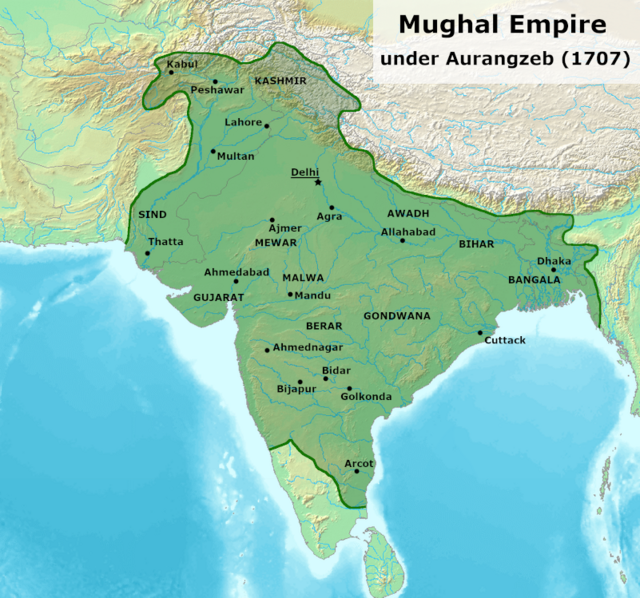
| Portrait | Titular Name | Birth Name | Birth | Reign | Death |
|---|---|---|---|---|---|
1  |
Babur بابر |
Zahir Ud-Din Muhammad Ghazi ظہیر الدین محمد |
14 February 1483 Andijan, Uzbekistan | 20 April 1526 – 26 December 1530
(4 years 8 months 9 days) |
26 December 1530 (aged 47) Agra, India |
2  |
Humayun ہمایوں |
Nasir Ud-Din Baig Muhammad Khan ناصر الدین بیگ محمد خان |
6 March 1508 Kabul, Afghanistan | 26 December 1530 – 17 May 1540 |

| S. n. | Picture | Name | Birth date | Death date | Reign | Notes |
|---|---|---|---|---|---|---|
| 1st |  |
Sher Shah Suri | 1472 or 1486 | 22 May 1545 | 6 April 1538/17 May 1540[22][23] — 22 May 1545[23] | |
| 2nd |  |
Islam Shah Suri | 1507 | 22 November 1554 | 26 May 1545[24] — 22 November 1554[24] | Son of Sher Shah Suri. |
| 3rd | Firuz Shah Suri | 4 May 1542 | 1554 | 1554[25] | Son of Islam Shah Suri. | |
| 4th | Muhammad Adil Shah | unknown | 1557 | 1554[25] — 1555[26] | Son-in-law of Sher Shah Suri. | |
| 5th | Ibrahim Shah Suri | unknown | 1567/1568 | 1555[26] | Brother-in-law of Sher Shah Suri. | |
| 6th | Sikandar Shah Suri | unknown | 1559 | 1555[26] — 22 June 1555[26] | Brother-in-law of Sher Shah Suri. | |
| 7th | Adil Shah Suri | unknown | April 1557 | 22 June 1555[26] — 1556[26] | Brother of Sikandar Shah Suri. |
| Portrait | Titular Name | Birth Name | Birth | Reign | Death |
|---|---|---|---|---|---|
2  |
Humayun ہمایوں |
Nasir Ud-Din Baig Muhammad Khan ناصر الدین بیگ محمد خان |
6 March 1508 Kabul, Afghanistan | 22 February 1555 – 27 January 1556
(10 years 3 months 25 days) |
27 January 1556 (aged 47) Delhi, India |
3  |
Akbar اکبر |
Abu'l Fath Jalal Ud-Din Muhammad ابوالفتح جلال الدین محمد |
15 October 1542 Umerkot, Pakistan | 11 February 1556 – 27 October 1605
(49 years 9 months 0 days) |
27 October 1605 (aged 63) Agra, India |
4  |
Jahangir جہانگیر |
Nur Ud-Din Baig Muhammad khan Salim نورالدین بیگ محمد خان سلیم |
31 August 1569 Agra, India | 3 November 1605 – 28 October 1627
(21 years 11 months 23 days) |
28 October 1627 (aged 58) Jammu and Kashmir, India |
5  |
Shah Jahan شاہ جہان |
Shahab Ud-Din Muhammad Khurram شہاب الدین محمد خرم |
5 January 1592 Lahore, Pakistan | 19 January 1628 – 31 July 1658
(30 years 8 months 25 days) |
22 January 1666 (aged 74) Agra, India |
6  |
Aurangzeb اورنگزیب Alamgir |
Muhi Ud-Din Muhammad محی الدین محمد |
3 November 1618 Gujarat, India | 31 July 1658 – 3 March 1707
(48 years 7 months 0 days) |
3 March 1707 (aged 88) Ahmednagar, India |
7  |
Azam Shah اعظم شاہ |
Qutb Ud-Din Muhammad قطب الدين محمد |
28 June 1653 Burhanpur, India | 14 March 1707 – 20 June 1707 | 20 June 1707 (aged 53) Agra, India |
8  |
Bahadur Shah بہادر شاہ Shah Alam |
Abul-Nasr Sayyid Qutb-ud-din Mirza Muhammad Muazzam ابوالنصر سید قطب الدین مرزا محمد معظم |
14 October 1643 Burhanpur, India | 19 June 1707 – 27 February 1712
(4 years, 253 days) |
27 February 1712 (aged 68) Lahore, Pakistan |
9  |
Jahandar Shah جہاندار شاہ |
Mu'izz-ud-Din Beg Muhammad Khan Bahādur معیز الدین بیگ محمد خان بہادر |
9 May 1661 Deccan, India | 27 February 1712 – 11 February 1713
(0 years, 350 days) |
12 February 1713 (aged 51) Delhi, India |
10 |
Farrukhsiyar فرخ سیر |
Abu'l Muzaffar Muīn-ud-Dīn Muhammad Shāh Farrukhsiyar Alim Akbar Sāni Wālā Shān Pādshāh-i-bahr-u-bar ابوالمظفر معین الدین محمد شاہ فرخ سیار علیم اکبر ثانی والا شان پادشاہ البحر البر Puppet King Under the Sayyids of Barha |
20 August 1685 Aurangabad, India | 11 January 1713 – 28 February 1719
(6 years, 48 days) |
19 April 1719 (aged 33) Delhi, India |
11 |
Rafi ud-Darajat رفیع الدرجات |
Abu'l Barakat Shams-ud-Din Muhammad Rafi ud-Darajat Padshah Ghazi Shahanshah-i-Bahr-u-Bar ابوالبرکات شمس الدین محمد رفیع الدراجات پادشاہ غازی شہنشاہ البحر البر Puppet King Under the Sayyids of Barha |
1 December 1699 | 28 February 1719 – 6 June 1719
(0 years, 98 days) |
6 June 1719 (aged 19) Agra, India |
12 |
Shah Jahan II شاہ جہان دوم |
Rafi-ud-Din Muhammad Rafi-ud-Daulah رفیع الدین محمد رفیع الدولہ Puppet King Under the Sayyids of Barha |
5 January 1696 | 6 June 1719 – 17 September 1719
(0 years, 105 days) |
18 September 1719 (aged 23) Agra, India |
13 |
Muhammad Shah محمد شاہ |
Nasir-ud-Din Muḥammad Shah Roshan Akhtar Bahadur Ghazi ناصر الدین محمد شاہ روشن اختر بہادر غازی Puppet King Under the Sayyids of Barha |
7 August 1702 Ghazni, Afghanistan | 27 September 1719 – 26 April 1748
(28 years, 212 days) |
26 April 1748 (aged 45) Delhi, India |
14 |
Ahmad Shah Bahadur احمد شاہ بہادر |
Abu-Nasir Mujahid ud-din Muhammad Ahmad Shah Bahadur Ghazi ابو ناصر مجاہد الدین محمد احمد شاہ بہادر غازی |
23 December 1725 Delhi, India | 29 April 1748 – 2 June 1754
(6 years, 37 days) |
1 January 1775 (aged 49) Delhi, India |
15 |
Alamgir II عالمگیر دوم |
Aziz Ud-Din Muhammad عزیز اُلدین محمد |
6 June 1699 Burhanpur, India | 3 June 1754 – 29 November 1759
(5 years, 180 days) |
29 November 1759 (aged 60) Kotla Fateh Shah, India |
16 |
Shah Jahan III شاہ جہان سوم |
Muhi Ul-Millat محی اُلملت |
1711 | 10 December 1759 – 10 October 1760
(282 days) |
1772 (aged 60–61) |
17 |
Shah Alam II شاہ عالم دوم |
Abdu'llah Jalal ud-din Abu'l Muzaffar Ham ud-din Muhammad 'Mirza Ali Gauhar عبدالله جلال الدین ابوالمظفر هم الدین محمد میرزا علی گوهر شاه علم دوم |
25 June 1728 Delhi, India | 10 October 1760 – 31 July 1788
(27 years, 301 days) |
19 November 1806 (aged 78) Delhi, India |
18 |
Shah Jahan IV جہان شاه چہارم |
Bidar Bakht Mahmud Shah Bahadur Jahan Shah بیدار بخت محمود شاه بهادر جہان شاہ |
1749 Delhi, India | 31 July 1788 – 11 October 1788
(63 days) |
1790 (aged 40–41) Delhi, India |
19 |
Shah Alam II شاہ عالم دوم |
Abdu'llah Jalal ud-din Abu'l Muzaffar Ham ud-din Muhammad 'Mirza Ali Gauhar عبدالله جلال الدین ابوالمظفر هم الدین محمد میرزا علی گوهر شاه علم دوم Puppet King under the Maratha Empire |
25 June 1728 Delhi, India | 16 October 1788 – 19 November 1806
(18 years, 339 days) |
19 November 1806 (aged 78) Delhi, India |
20 |
Akbar Shah II اکبر شاہ دوم |
Sultan Ibn Sultan Sahib al-Mufazi Wali Ni'mat Haqiqi Khudavand Mujazi Abu Nasir Mu'in al-Din Muhammad Akbar Shah Pad-Shah Ghazi سلطان ابن سلطان صاحب المفاضی ولی نعمت حقی خداوند مجازی ابو ناصر معین الدین محمد اکبر شاہ پاد شاہ غازی Puppet King under the East India Company |
22 April 1760 Mukundpur, India | 19 November 1806 – 28 September 1837
(30 years, 321 days) |
28 September 1837 (aged 77) Delhi, India |
21 |
Bahadur Shah II Zafar بہادر شاہ ظفر |
Abu Zafar Siraj Ud-Din Muhammad ابو ظفر سراج اُلدین محمد |
24 October 1775 Delhi, India | 28 September 1837 – 21 September 1857
(19 years, 360 days) |
7 November 1862 (aged 87) Rangoon, Myanmar |

| Name | Lifespan | Reign start | Reign end | Notes | Family | Image |
|---|---|---|---|---|---|---|
Ahmad Shah Durrani
| 1720/1722 – 4 June 1772 | 1747 | 1758 | Established the Durrani dynasty and the Durrani Empire; Considered founder of modern Afghanistan | Durrani |  |
| Timur Shah Durrani | December 1746 – 20 May 1793 | November 1772 | 20 May 1793 | Son of Ahmad Shah Durrani Preserved the Durrani Empire following the death of his father after fighting off civil war in 1772, and multiple rebellions | Durrani |  |
| Zaman Shah Durrani | 1770–1844 | 20 May 1793 | 25 July 1801 (deposed) | Son of Timur Shah Durrani Engaged in civil war with his brothers after the death of his father, later being deposed | Durrani |  |
Mahmud Shah Durrani
| 1769 – 18 April 1829 | 25 July 1801 | 13 July 1803 (deposed) | Son of Timur Shah Durrani Engaged in civil war with his brothers after the death of his father, later being deposed | Durrani |  |
Shah Shujah Durrani
| 4 November 1785 – 5 April 1842 | 13 July 1803 | 3 May 1809 (deposed) | Son of Timur Shah Durrani Engaged in civil war with his brothers after the death of his father, later being deposed, and making multiple attempts to reclaim his throne | Durrani |  |
| Name
(Birth–Death) |
Portrait | Reign | Ref. |
|---|---|---|---|
| Jassa Singh Ramgarhia (1723 – 20 April 1803) |
 |
1748 – 1803 | [27][28] |
| Jodh Singh Ramgarhia (died August 1815) |
 |
1803 – 1808 | [29][28] |

| Nawab Amir of Bahawalpur | Tenure |
|---|---|
| Bahawal Khan Abbasi I | 1748 – 1750 |
| Mubarak Khan Abbasi II | 1750 – 1772 |
| Bahawal Khan Abbasi II | 1772 – 1809 |
| Sadeq Khan Abbasi II | 1809 – 1827 |
| Bahawal Khan Abbasi III | 1827 – 1852 |
| Sadeq Khan Abbasi III | 1852 – 1853 |
| Fath Mohammad Khan Abbasi | 1853 – 1858 |
| Rahim Yaar Khan Abbasi | 1858 – 1866 |
| Sadeq Khan Abbasi IV | 1866 – 1899 |
| Bahawal Khan Abbasi V | 1899 – 1907 |
| Sadeq Khan Abbasi V | 1907 – 1955 |
| Name
(Birth–Death) |
Portrait | Reign |
|---|---|---|
| Adina Beg Khan (1710 – 15 September 1758) |
 |
10 April 1758 – 15 September 1758 |
| No. | Name
(Birth–Death) |
Portrait | Reign | Enthronement | Ref. |
|---|---|---|---|---|---|
| Sardars | |||||
| 1 | Ala Singh (1691 or 1695 – 1765) |
 |
1709 – 1765 | ? | [31]: 188–215 [32] |
| Maharajas | |||||
| 2 | Amar Singh (7 June 1748 – February 1781) |
 |
1765 – 1781 | ? | [27][32] |
| 3 | Sahib Singh (18 August 1773 – 26 March 1813) |
 |
1781 – 1813 | ? | [27][32] |
| 4 | Karam Singh (12 October 1797 – 23 December 1845) |
 |
1813 – 1845 | 30 June 1813 | [27][32] |
| 5 | Narinder Singh (26 October 1824 – 13 November 1862) |
 |
1845 – 1862 | 18 January 1846 | [27] |
| 6 | Mahendra Singh (16 September 1852 – 13 or 14 April 1876) |
 |
1862 – 1876 | 29 January 1863 | [27] |
| 7 | Rajinder Singh (25 May 1872 – 8 November 1900) |
 |
1876 – 1900 | 6 January 1877 | [27] |
| 8 | Bhupinder Singh (12 October 1891 – 1938) |
 |
1900 – 1938 | ? | [27] |
| 9 | Yadavindra Singh (7 January 1913 – 17 June 1974) |
 |
1938 – 1974 | ? | [27] |
| No. | Name
(Birth–Death) |
Portrait | Reign | Enthronement | Ref. |
|---|---|---|---|---|---|
| Sardars | |||||
| 1 | Sukhchain Singh (1683 – 1758) |
? | ? – 1758 | ? | [31] |
| Rajas | |||||
| 2 | Gajpat Singh (15 April 1738 – 11 November 1789) |
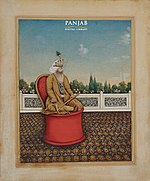 |
1758 – 1789 | ? | [33][27] |
| 3 | Bhag Singh (23 September 1760 – 16 June 1819) |
 |
1789 – 1819 | November 1789 | [33][27] |
| 4 | Fateh Singh (6 May 1789 – 3 February 1822) |
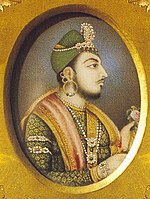 |
1819 – 1822 | ? | [33][27] |
| 5 | Sangat Singh (16 July 1810 – 4/5 November 1834) |
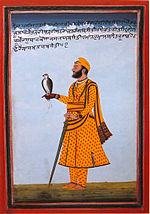 |
1822 – 1834 | 30 July 1822 | [33][27] |
| 6 | Swarup Singh (30 May 1812 – 26 January 1864) |
 |
1834 – 1864 | April 1837 | [33][27] |
| 7 | Raghubir Singh (1832 – 7 March 1887) |
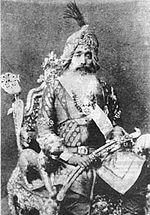 |
1864 – 1887 | 31 March 1864 | [33][27] |
| 8 | Ranbir Singh (11 October 1879 – 1 April 1948) |
 |
1887 – 1948 | 27 February 1888 | [33][27][34] |
| No. | Name
(Birth–Death) |
Portrait | Reign | Enthronement | Ref. |
|---|---|---|---|---|---|
| Sardars | |||||
| 1 | Hamir Singh (died 1783) |
 |
1754 – 1783 | ? | [27] |
| Rajas | |||||
| 2 | Jaswant Singh (1775 – 22 May 1840) |
 |
1783 – 1840 | ? | [27] |
| 3 | Devinder Singh (5 September 1822 – 14/15 November 1865) |
 |
1840 – 1846 | 15 October 1840 | [27] |
| 4 | Bharpur Singh (5 October 1840 – 9 November 1863) |
 |
1846 – 1863 | ? | [27] |
| 5 | Bhagwan Singh (30 November 1842 – 31 May 1871) |
 |
1863 – 1871 | 17 February 1864 | [27] |
| Maharajas | |||||
| 6 | Hira Singh (19 December 1843 – 24 December 1911) |
 |
1871 – 1911 | 10 August 1871 | [27] |
| 7 | Ripudaman Singh (4 March 1883 – 14 December 1942) |
 |
1911 – 1923 | 24 January 1912 | [27] |
| 8 | Partap Singh (21 September 1919 – 22 July 1995) |
 |
1923 – 1948 | [27] | |
| No. | Name
(Birth–Death) |
Portrait | Reign | Ref. |
|---|---|---|---|---|
| Sardars | ||||
| 1 | Jassa Singh Ahluwalia (1718–1783) |
 |
1777 – 20 October 1783 | [35][27] |
| 2 | Bagh Singh Ahluwalia (1747–1801) |
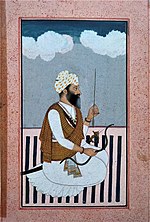 |
20 October 1783 – 10 July 1801 | [citation needed] |
| Rajas | ||||
| 3 | Fateh Singh Ahluwalia (1784–1837) |
 |
10 July 1801 – 20 October 1837 | [36][37][38] |
| 4 | Nihal Singh (1817–1852) |
 |
20 October 1837 – 13 September 1852 | |
| 5 | Randhir Singh (1831–1870) |
 |
13 September 1852 – 12 March 1861 | [27] |
| Raja-i Rajgan | ||||
| – | Randhir Singh (1831–1870) |
 |
12 March 1861 – 2 April 1870 | [27] |
| 6 | Kharak Singh (1850–1877) |
 |
2 April 1870 – 3 September 1877 | |
| 7 | Jagatjit Singh (1872–1949) |
 |
3 September 1877 – 12 December 1911 | [27] |
| Maharajas | ||||
| – | Jagatjit Singh (1872–1949) |
 |
12 December 1911 – 15 August 1947 | [27] |
| Titular | ||||
| – | Jagatjit Singh (1872–1949) |
 |
15 August 1947 – 19 June 1949 | [27] |
| 8 | Paramjit Singh | |||
| 9 | Sukhjit Singh |  |
||

| S. No. | Name | Portrait | Birth and death | Reign | Note | ||||
|---|---|---|---|---|---|---|---|---|---|
| 1 | Maharaja Ranjit Singh |  |
13 November 1780 (Gujranwala) | 27 June 1839 (Lahore) | 12 April 1801 | 27 June 1839 | 38 years, 76 days | The first Sikh ruler | Stroke |
| 2 | Maharaja Kharak Singh |  |
22 February 1801 (Lahore) | 5 November 1840 (Lahore) | 27 June 1839 | 8 October 1839 | 103 days | Son of Ranjit Singh | Poisoning |
| 3 | Maharaja Nau Nihal Singh |  |
11 February 1820 (Lahore) | 6 November 1840 (Lahore) | 8 October 1839 | 6 November 1840 | 1 year, 29 days | Son of Kharak Singh | Assassinated |
| 4 | Maharani Chand Kaur |
 |
1802 (Fatehgarh Churian) | 11 June 1842 (Lahore) | 6 November 1840 | 18 January 1841 | 73 days | Wife of Kharak Singh and the only female ruler of Sikh Empire | Abdicated |
| 5 | Maharaja Sher Singh |  |
4 December 1807 (Batala) | 15 September 1843 (Lahore) | 18 January 1841 | 15 September 1843 | 2 years, 240 days | Son of Ranjit Singh | Assassinated |
| 6 | Maharaja Duleep Singh |  |
6 September 1838 (Lahore) | 22 October 1893 (Paris) | 15 September 1843 | 29 March 1849 | 5 years, 195 days | Son of Ranjit Singh | Exiled |
| 7 | Maharani Jind Kaur (regent; nominal) |
 |
1817 (Gujranwala) | 1 August 1863 (Kensington) | 15 September 1843 | 29 March 1849 | 5 years, 195 days | Wife of Ranjit Singh | Exiled |
Seamless Wikipedia browsing. On steroids.
Every time you click a link to Wikipedia, Wiktionary or Wikiquote in your browser's search results, it will show the modern Wikiwand interface.
Wikiwand extension is a five stars, simple, with minimum permission required to keep your browsing private, safe and transparent.